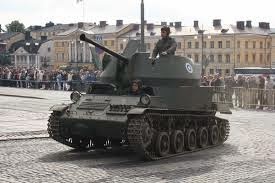Landsverk Anti II eli Luftvärnskanonvagn L-62 Anti II on ruotsalainen toisen maailmansodan aikanen ilmatorjuntapanssarivaunu.
Se kehitettiin vuosina 1941–1942.
Sen perustana oli unkarilainen Toldi-panssarivaunu jota oli valmistettu ruotsalaiselta AB Landsverkiltä hankitulla lisenssillä. Vaunussa oli Boforsin 40 mm ilmatorjuntakanuuna, joka Suomessa tunnetaan nimellä 40 ItK 38.
Suomi sai käyttöönsä kuusi Anti II -vaunua vuonna 1942. Kesän 1944 aikana suomalaisten vaunut pudottivat tykeillään 11 neuvostoliiton lentokonetta. Vaunut selvisivät sodasta ehjinä ja niitä käytettiin aina vuoteen 1966 asti.
------------------------------------------
Luftvärnskanonvagn L-62 anti II, also known as Landsverk anti-II or L-62 or locally ItPsv 41, was a Swedish self-propelled anti-aircraft gun that was developed specifically for Finland between 1941 and 1942. The vehicle was developed from the Toldi L-60 m/38 tank.
The chassis was lengthened and an 40 mm Bofors AA-gun added. The gun was called 40 ItK/38 in Finnish service.
The tank was exported to Hungary, where it was further developed into an AA-tank called 40M Nimrod. 135 Nimrods were built, and Finland bought six tanks in 1942. All tanks survived the war and were used until 1966.
During the battles in the summer of 1944, the Finnish tanks downed eleven Soviet aircraft and thus prevented attacks against the tank brigade.
----------------------------------
Landsverk Anti-II at the AA-museum in Tuusula, Finland.
Luftvärnskanonvagn L-62 Anti II
Type: Self-propelled anti-aircraft gun
Place of origin: Sweden
Service history
Used by: Finland
Kingdom of Hungary
Wars: World War II
Production history
Manufacturer: AB Landsverk
Variants: 40M Nimród (Hungarian version based on a license-built copy)
Weight: 9.5 ton
Length:5. 32 m (17 ft 5 in)
Width: 2.30 m (7 ft 7 in)
Height: 2.30 m (7 ft 7 in)
Crew: 5
Armor: 6–20 mm (0.24–0.79 in)
Main armament: 40 mm Bofors L/50 anti-aircraft gun
Engine: L8V / 36 T Scania 1664 cc / 155 hp
Speed: 40 km/h (25 mph)
-------------------------------------------
In late 1920 the company found itself on the verge of bankruptcy. Through a Dutch company, the German Gutehoffnungshütte Aktienverein für Bergbau und Hüttenbereich Oberhausen (GHH), invested heavily and gained control of 50% of the shares.
In 1923 the company manufactured a small number of tracked agricultural tractors based on an American design. The Germans increased their ownership to 61% in 1925, three years later the name was changed to AB Landsverk. In 1929 the German engineer Otto Merker was assigned to Landsverk to develop armoured vehicles, a few prototypes of a German design with both wheels and tracks were manufactured in Landskrona. In 1930 the Swedish Army ordered an armoured car for trials, and a few years later three light tanks on wheels and tracks.
In 1933 Lithuania ordered six, in 1935 the Netherlands twelve Landsverk L181 and 1n 1937 an order of thirteen L-180 armoured cars. Landsverk presented the L-60 in 1934, the first tank with torsion-bar suspension. There was some very limited export of armoured cars to other countries like Denmark and Finland. Hungary manufactured the L-60 as the Toldi. The Landsverk anti-II was an AA variant of this tank.
Landsverk built a few L-120 light tanks in the 1930s, one of which was exported to Norway, it was the first tank operated by the Norwegian Army.
--------------------------------------------
During the Second World War Landsverk designed and partly manufactured, most of the Swedish Army's tanks. At the conclusion of that conflict Landsverk was confiscated by the Swedish state and sold to Kockums.
The Irish Army operated several Landsverk vehicles over the last 80 years. Two L-60 tanks were purchased in 1935 as training vehicles to supplement the single Vickers Mk D. Although three tanks were of dubious military value, budget constraints prevented additional purchases. Both were out of service by 1953 due to a lack of tracks. Both are still in existence, one has been restored to working condition.
The Irish Army also used the L-180 armoured car. The type was adopted to replace the aging Rolls Royce fleet in 1937. Eight were delivered by 1939, but the last five on order were never delivered due to the outbreak of the Second World War. The same was the case with many other vehicles in the Irish Army, budget constraints meant that the L180s were still in front-line service (albeit up-gunned with 20mm cannon) until 1972. Incredibly, they were then transferred to the Irish Army Reserve, the FCA, where they were kept in service until the mid-1980s. 5 are preserved, including one donated to the Swedish Army.

.jpg)




Ei kommentteja:
Lähetä kommentti
Any explosive ammunition or empty cores, you can put in this.